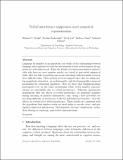Verbal interference suppresses exact numerical representation
Author(s)
Frank, Michael C.; Fedorenko, Evelina; Lai, Peter; Saxe, Rebecca R.; Gibson, Edward A.
DownloadFrank et al. Cognitive Psychology 2012[1].pdf (635.9Kb)
PUBLISHER_CC
Publisher with Creative Commons License
Creative Commons Attribution
Terms of use
Metadata
Show full item recordAbstract
Language for number is an important case study of the relationship between language and cognition because the mechanisms of non-verbal numerical cognition are well-understood. When the Pirahã (an Amazonian hunter-gatherer tribe who have no exact number words) are tested in non-verbal numerical tasks, they are able to perform one-to-one matching tasks but make errors in more difficult tasks. Their pattern of errors suggests that they are using analog magnitude estimation, an evolutionarily- and developmentally-conserved mechanism for estimating quantities. Here we show that English-speaking participants rely on the same mechanisms when verbal number representations are unavailable due to verbal interference. Followup experiments demonstrate that the effects of verbal interference are primarily manifest during encoding of quantity information, and—using a new procedure for matching difficulty of interference tasks for individual participants—that the effects are restricted to verbal interference. These results are consistent with the hypothesis that number words are used online to encode, store, and manipulate numerical information. This linguistic strategy complements, rather than altering or replacing, non-verbal representations.
Date issued
2011-11Department
Massachusetts Institute of Technology. Department of Brain and Cognitive SciencesJournal
Cognitive Psychology
Publisher
Elsevier
Citation
Frank, Michael C., Evelina Fedorenko, Peter Lai, Rebecca Saxe, and Edward Gibson. “Verbal Interference Suppresses Exact Numerical Representation.” Cognitive Psychology 64, no. 1–2 (February 2012): 74–92.
Version: Author's final manuscript
ISSN
00100285
1095-5623